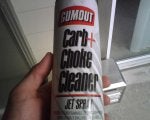Hi,
Basically i think my ide control valve is to be playing up (what i get after looking at other threads). Every now and again on a cold start-up, i have to top up the revs to stop the car from dying, but after that it is totally fine, even if i stop the car at the end of the road, it will idle nicely around 800rpm. It is annoying, but it doesn't happen that often so doesn't affect me too much. I am pretty confident that it isn't anything else because there is no lack of power and no other problems.
1. Will it damage the car if i leave it? (money is a bit tight at the moment so am trying to avoid any unnecessary expense)
2. How can i test to see if it is anyfin else?
Cheers in advance
Basically i think my ide control valve is to be playing up (what i get after looking at other threads). Every now and again on a cold start-up, i have to top up the revs to stop the car from dying, but after that it is totally fine, even if i stop the car at the end of the road, it will idle nicely around 800rpm. It is annoying, but it doesn't happen that often so doesn't affect me too much. I am pretty confident that it isn't anything else because there is no lack of power and no other problems.
1. Will it damage the car if i leave it? (money is a bit tight at the moment so am trying to avoid any unnecessary expense)
2. How can i test to see if it is anyfin else?
Cheers in advance





